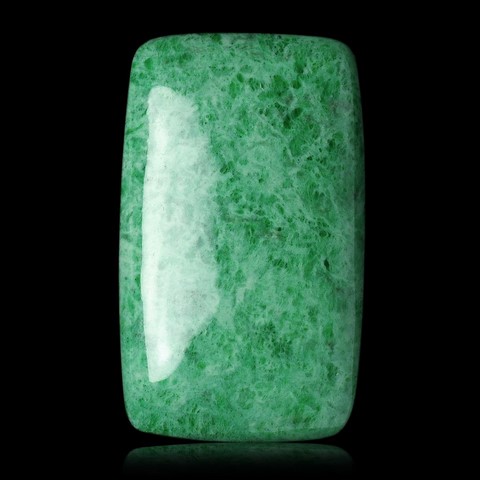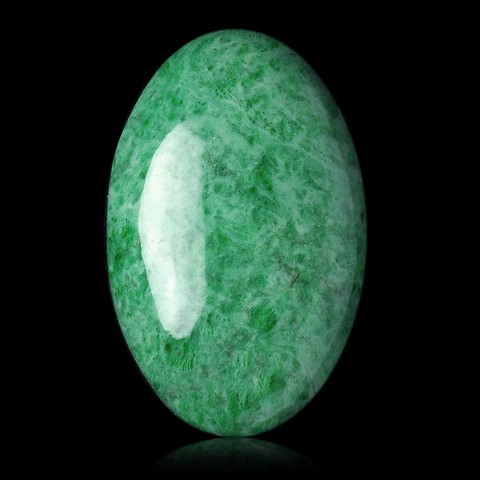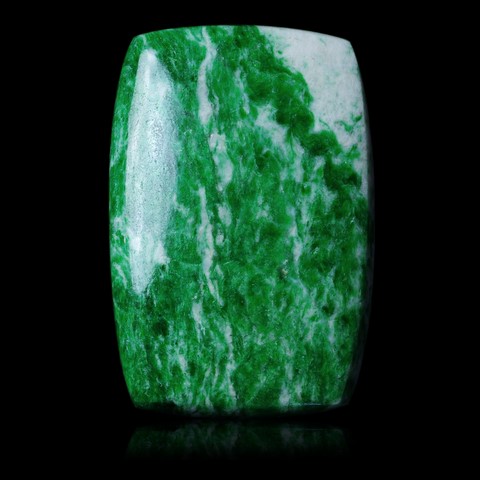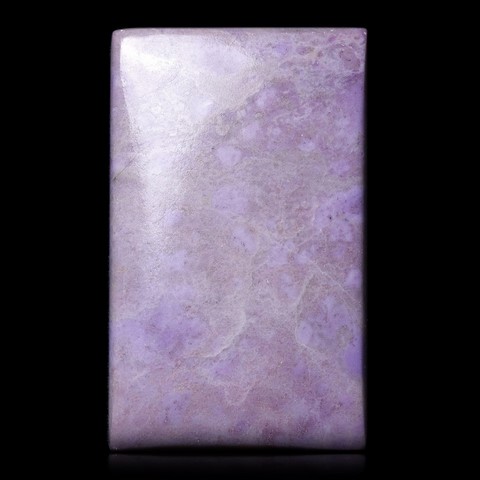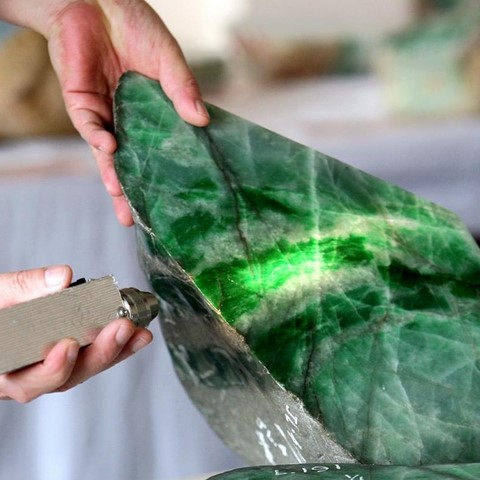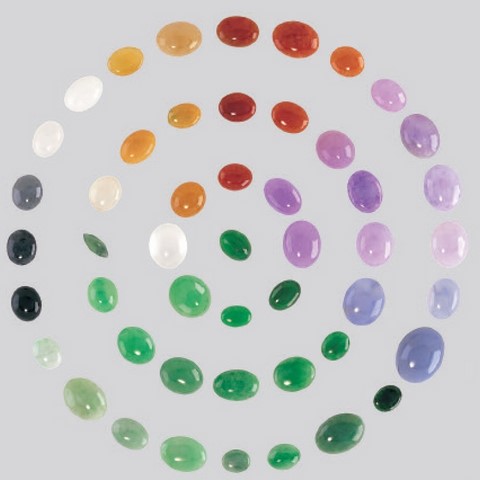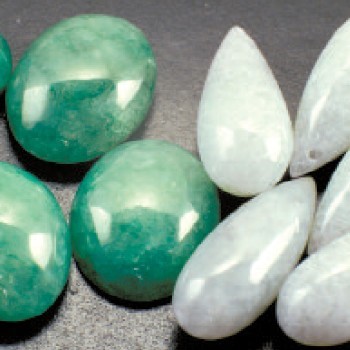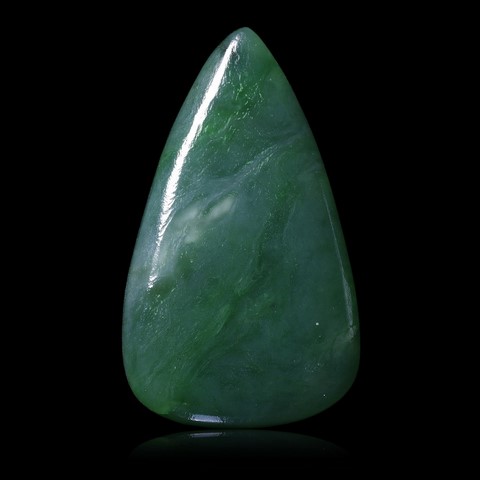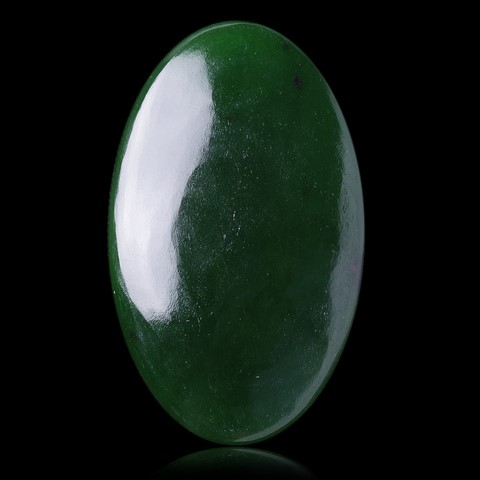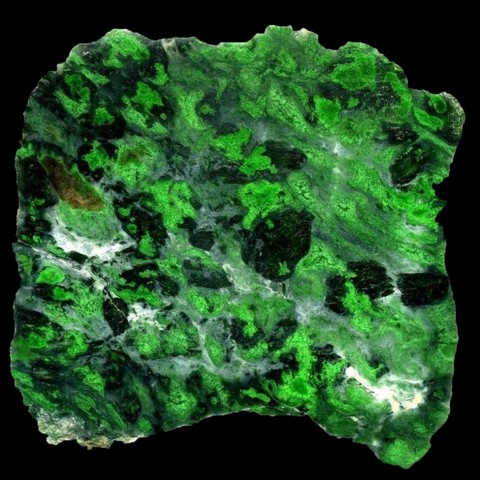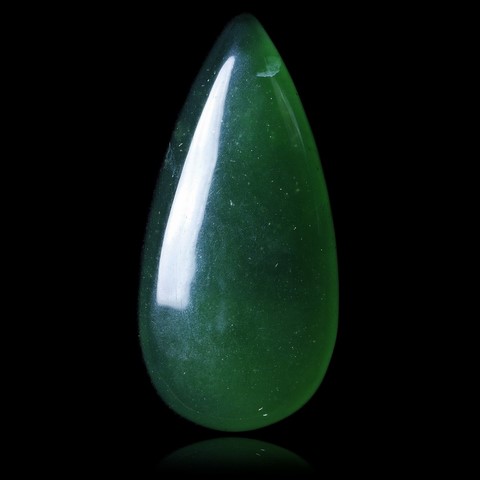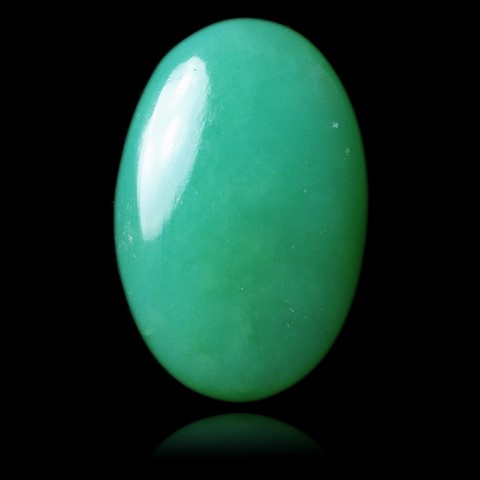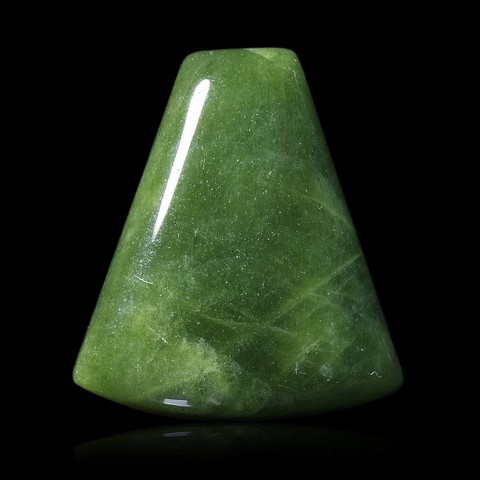JADEITE
Class : Silicates
Subclass : Inosilicates
Crystal system : Monoclinic
Chemistry : NaAlSi2O6
Rarity : Rare
Jadeite (also called jade) is a sodium pyroxene from the clinopyroxene family. It is a mineral typical of metamorphic rocks of low temperature and high pressure (glaucophane schists or blue schist, eclogites), where it accompanies glaucophane and albite. More rarely, it is present in gabbros, alkaline magmatic rocks or serpentinites. Jadeite is rare in primary deposits, it is found mainly in pebbles in alluvium. It owes its name to the Spanish piedra de yjada (stone on the side), this mineral had a reputation for having the power to relieve kidney disease. It is exceptional in small elongated prismatic crystals, it is most often found in grainy or compact aggregates, in very tenacious cryptocrystalline masses with fibrous structures. Its color is white to greenish, apple green to emerald green, rarely purplish or bluish green. It is most often translucent, but perhaps semi-transparent in exceptional quality. It is a mineral widely used and appreciated in ornamentation in Asia (especially in China). Its extraordinary tenacity explains its use as an ax in the Neolithic.
Jadeite in the World
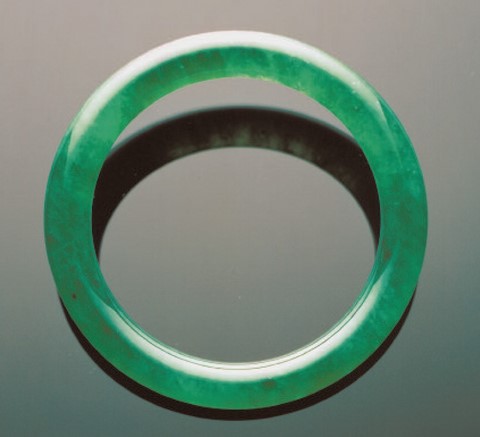
The semi-transparent jadeite bracelet on the right is of Chinese origin (photo © Tino Hammid 1998), it is supposed to provide protection and tranquility to its wearer. This superb jadeite rush sold for a modest sum of more than $ 2.5 million at Christie’s Hong Kong in 1999.
Jadeite in France
In France, we find jadeite in traces in Breton blue schists and in the Massif de Roche Noir in a metamorphic gabbro.
Jadeite treatments
Because the right combinations of color, transparency, and texture can increase the value of jadeite to dramatic levels, many producers use treatments to improve its appearance.
Some of these treatments have been around for a very long time and are accepted as part of the traditional jadeite finishing process. On the other hand, other much more recent treatments have caused much troubles in the industry. In order to clarify the market and facilitate its understanding, jadeite is classified into three categories : Type A, Type B and Type C.
Jadeite type A : is natural jadeite that producers soak in melted wax after cutting and polishing to improve its luster and seal surface holes and fractures. To help the material absorb the wax and prevent cracks, manufacturers boil the jadeite in water before dipping it. The wax fills the spaces between the microscopic crystals and gives the jadeite a prettier appearance. This traditional treatment is extremely common and it does not affect the value.
Jadeite type B : is natural jadeite subjected to a series of treatments to improve its appearance. Manufacturers of type B jadeite soak the stone in hot hydrochloric or sulfuric acid for long periods. The acid whitens any unwanted brown or yellow oxidation stains. It also leaches sodium, which changes the chemical composition of jadeite. This compromises its durability, and it can become brittle. When jadeite is removed from the acid, the material is dull and chalky. It also contains tiny voids. To improve luster, transparency and color, manufacturers then fill the voids with wax or clear polymer resin. This makes jadeite more attractive and easier to sell. Most type B jadeites are sold without treatment. The process has been around since at least the mid-1970s'.
In the early 2000s, the market value of Type B jadeite was about one-tenth that of similarly looking Type A jadeite. The reason for its low value is that the treatment makes it brittle and unstable. Over a relatively short period, even a few months, the polymer sealants can decompose and the jadeite can lose its attractive color. Unfortunately, if the treatment is not disclosed, it is difficult to see it without performing infrared spectroscopy, an analysis which is generally carried out in gemology laboratories...
Jadeite type C : pushes the treatment a little further by introducing dye. As early as the 1950s', manufacturers experimented with plant dyes in an attempt to improve the color of pale jadeite. These organic dyes produce green, lavender and orange-brown hues that make the material more aesthetic. In the current jadeite market, type C jadeite is often dyed type B jadeite. The dye is concentrated in the surface cracks of jadeite. In most cases, the dye is added to the resin, but it can also be applied separately. The jadeite dyes are fading, especially the greens. Naturally, type C jadeite is worth much less than the other two types. The dye can be detected with a microscope and a spectroscope, but these devices cannot reveal the presence of polymer. Heat treatment is a method sometimes used to produce orange and reddish colors. The heat treatment is stable and undetectable.
Jadeite and Nephrite : the two real jades
Although the two materials are known as jade, there are very important differences between them. Jadeite is much rarer than nephrite, so it costs much more. Nephrite generally sells for a few euros per piece, while jadeite can sell for between several hundred and even tens of thousands of euros per piece. Another difference is the color. The best green of jadeite does not exist in nephrite. Instead, the greens of nephrite are more toned down, darker and less saturated. Like jadeite, nephrite is often streaked or spotted. In addition to green, nephrite can be yellow, red, brown, white, gray, black and even sometimes blue. The beautiful earthy colors of nephrite combined with its tenacity make it an ideal stone for carving. White is traditionally the most popular color, and was once reserved for royalty.
Substitutes
People have desired the lush greens of jadeite for thousands of years. Today, substitutes are as common as jadeite is rare. Most of these substitutes look like jadeite but should not be called "jade", only jadeite and nephrite are real jade and can be so called. Here are some of the most common jadeite substitutes :
Maw-sit-sit : this stone is extracted near Tawmaw, in Myanmar, and takes its name from its Asian source. It is an aggregate composed of several minerals, sometimes up to ten. And these minerals can be present in different proportions. The variable composition of the maw-sit-sit causes variations in its appearance. Its superior quality has a very saturated dark green color. The other shades range from light green to black. Color uniformity can vary from monochromatic to mottled, streaked or spotted. The marks are generally black and contrast pleasantly on their green background. The colors and patterns of the maw-sit-sit make it a frequent choice for magnificent modern sculptures. The more green the color and the more uniform the color, the more the maw-sit-sit looks like fine jadeite. The similarity in appearance, plus the fact that its source is also a jadeite extraction site creates some confusion in the market. Another point of confusion between the two stones is that the jadeite mineral is often a minor component of the maw-sit-sit. However, the maw-sit-sit should never be sold as "jade".
Serpentine (bowenite) : we can hear the terms "Korean jade" in trade. These terms refer to bowenite, a variety of serpentine that comes from Haeju in North Korea. For years, it has been a popular substitute for jadeite. Bowenite is similar in hardness to nephrite and may have magnetite inclusions. Like jadeite, its colors range from light green to dark green, sometimes mottled. In 1995, a gem-quality bowenite deposit was discovered in Korea, at Booyo, southwest of Seoul. It was marketed under the name "Booyo serpentine". Another bowenite, discovered in Pakistan in 1980 and introduced on the market in commercial quantities in 2000. Another deposit is also mined in India...
Chrysoprase : is a variety of nickel rich chalcedony with a natural green to yellow hue. Operated in Queensland, Australia, it appeared as a jade substitute in the mid-1960s'. It was called "Queensland jade" and was marketed in Asia.
Idocrase : In Butte County, near Chico, California, a translucent yellow-green stone called californite is offered as an alternative to jade. Its color and translucency closely resembles jade, and many in the trade call this variety of vesuvianite "California jade". She is also knowned under the name of idocrase. Like chalcedony, vesuvianite is hard and resistant. These qualities help make California a popular jade substitute.
Fakes and scams
A few decades ago, a common assembled stone consisted of two separate white jade parts. The halves were joined together with green cement or the cavity between them was filled with green dye before being glued together. This assembly can be difficult to detect, and the rendering very realistic.
More recently, two types of assembled jadeite imitations have become common. The first type is a triplet created with three pieces of almost transparent pale jadeite. The first piece is cut like a thin, hollow cabochon. A second cabochon fits inside the first after cement or green gel is inserted between them. A third piece of less transparent jadeite is cemented to form the base.
The second imitation of common jadeite consists of a piece of very dark green jadeite cut into a very thin hollow cabochon. The extremely fine cut lightens the dark tone of jadeite, making it look like fine imperial jadeite. To reinforce the fragile cabochon, the manufacturer fills the hollow back with an epoxy resin which is hidden when the assembled stone is set in jewelry...
Glass and plastic cabochons also imitate jadeite, but a keen eye can usually detect these imitations very easily. Glass, for example, often contains tiny bubbles of gas. It is also quite easy to distinguish plastic from jadeite simply by its density and thermal conductivity. Plastic is lighter because its density is much lower than that of jadeite. In addition, most plastics are soft, while jadeite is hard and does not show as much wear.
An imitation of jadeite, whether assembled, coated, stained or made of glass or plastic - can attract an unsuspecting buyer by its surface beauty. But these imitations are much less durable than jadeite and contain little precious material. Unfortunately, imitations are common, especially those located near production areas.
Another way for unscrupulous people to take advantage of jadeite is to make the jadeite rough more precious by dying or modifying it...
Hardness : 6
Density : 3.25 to 3.35
Fracture : Irregular
Streak : White
TP : Translucent to semi-transparent
IR : .654 to 1.693
Birefringence : 0.013 to 0.020
Optical character : Biaxial +
Pleochroism : Not visible
Fluorescence : None
Solubility : None
Magnetism : None
Radioactivity : None

